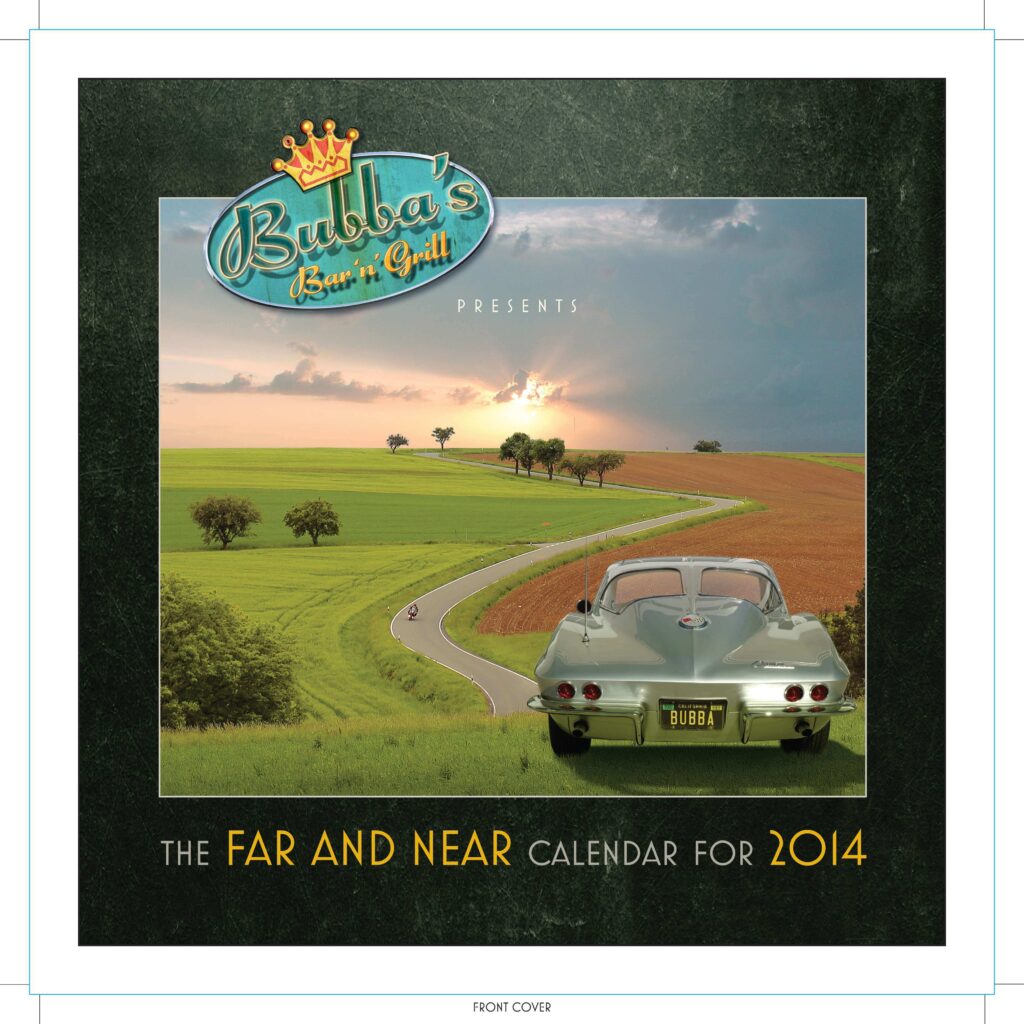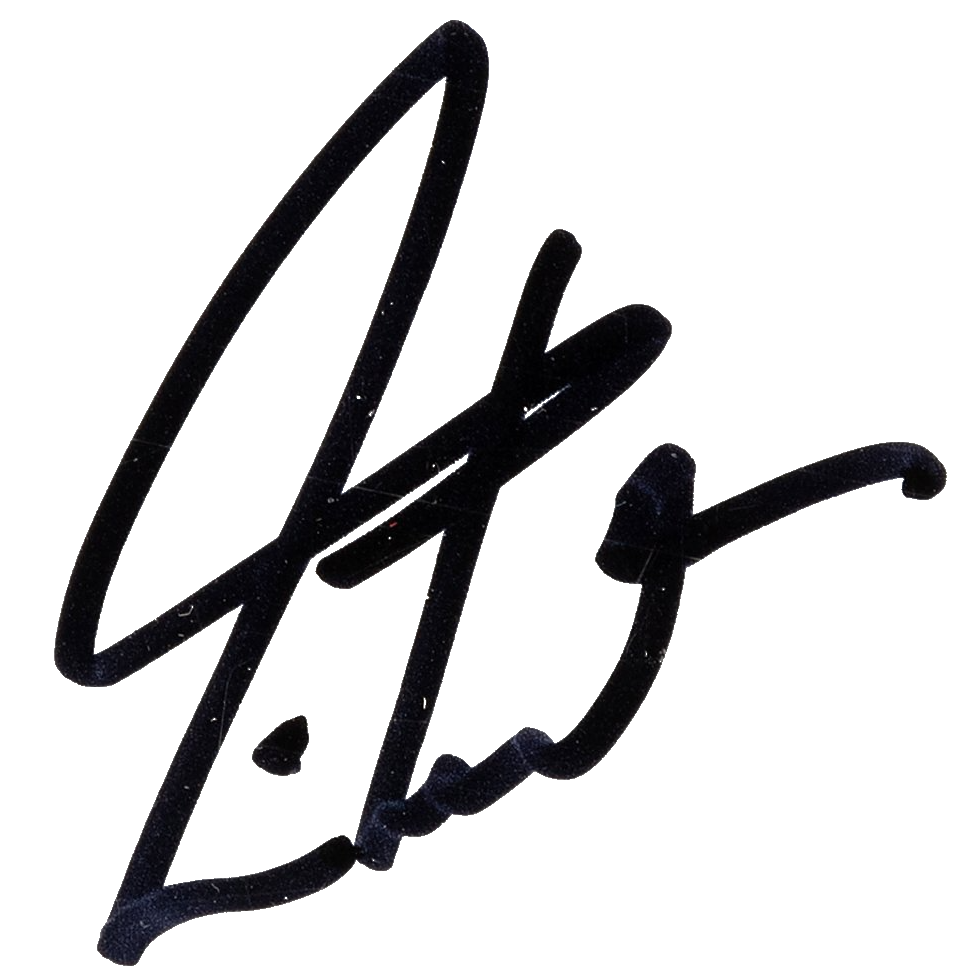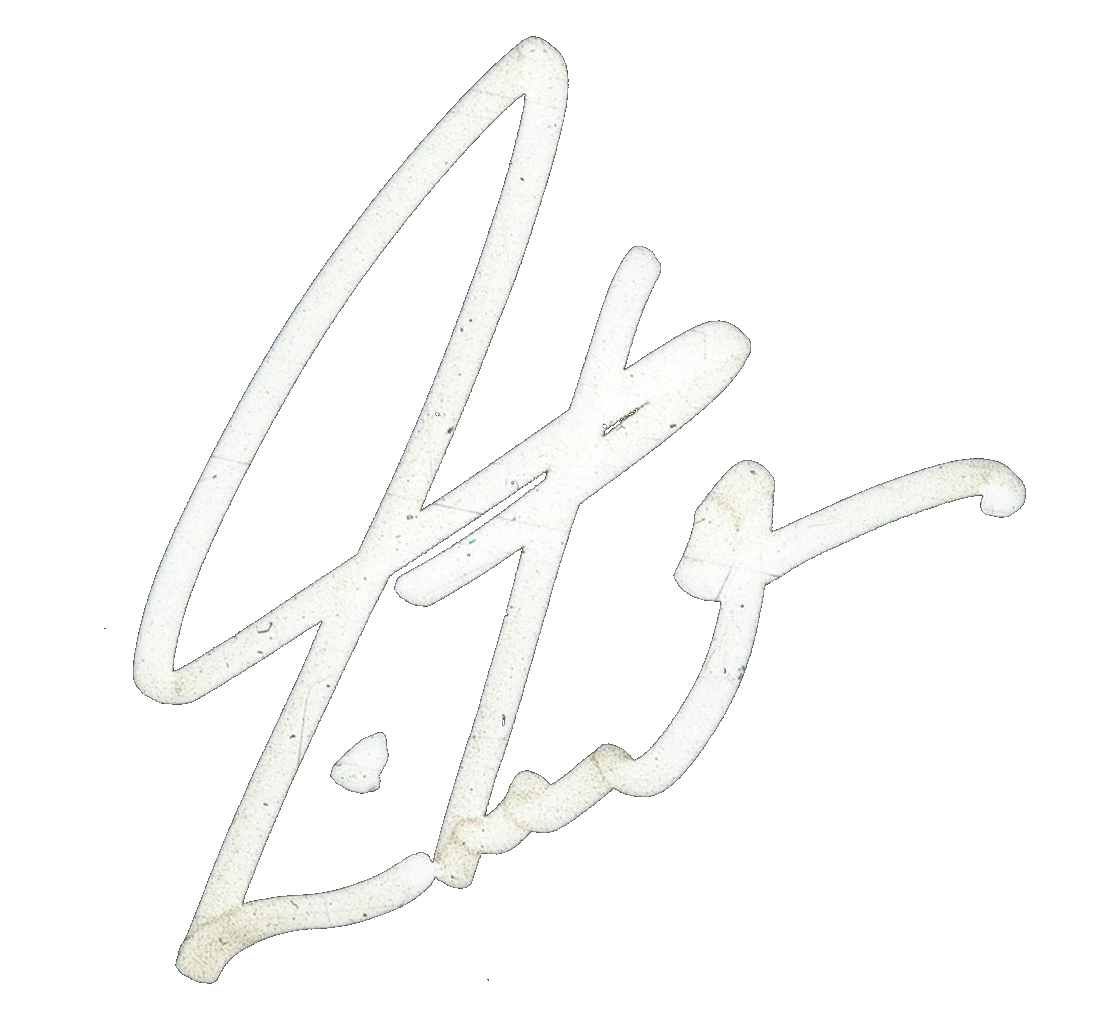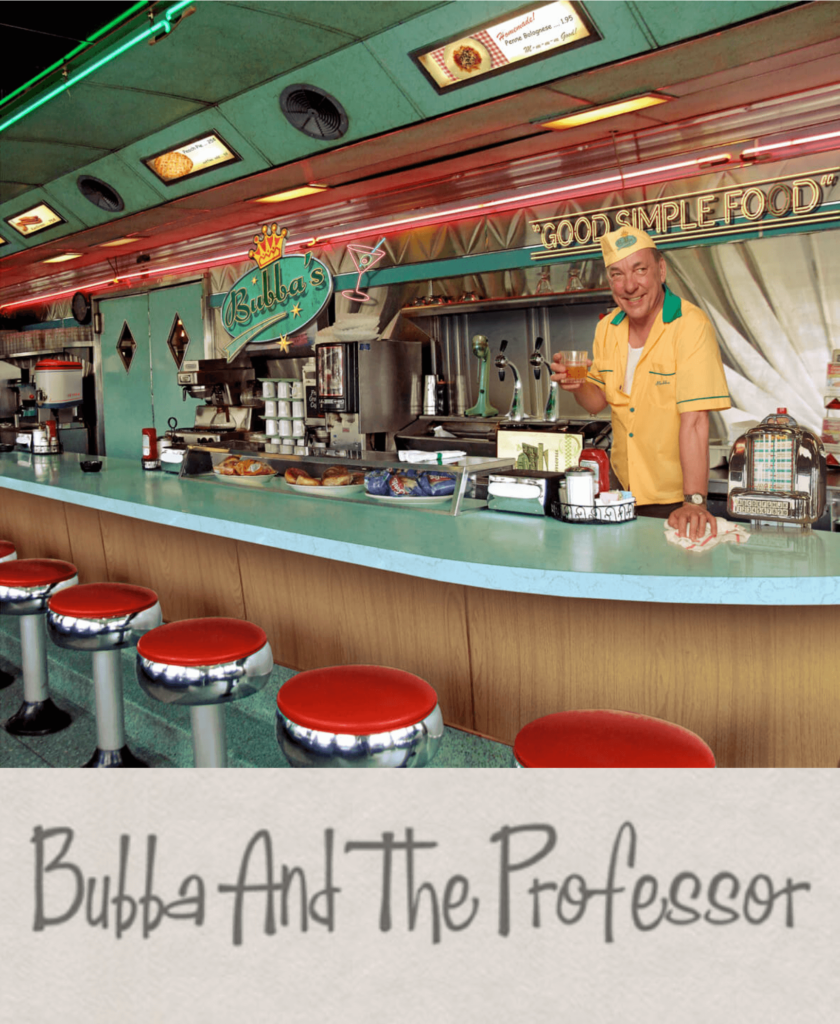
Can’t you just picture the ’60s sitcom, or wacky road movie, that would follow that title? Why, I can hear the theme music. The story would hinge on the classic “odd couple” setup, where a methodical, high-minded, would-be aesthete and intellectual is handcuffed to an easygoing neanderthal everythingaholic drummer.
You know, like the two polar sides of one character are tricked into sharing a long, difficult journey?
Oh wait—that’s my life.
What tales our nicknames can tell. The two in this title have been conferred upon one individual—your reporter—at different times in his life. You may imagine they come with a story or two.
I often think back to a “road lesson” involving one of my oldest friends, Jimmy Johnson. He and I met around 1968, when J.J. joined my second band, the Majority (ha—our booking agency’s genius slogan was “Join the Majority!”), as a “roadie.” A few tumultuous years later (for both of us), when I joined Rush, J.J. became Alex’s guitar tech for many years—many hilarious years. The two of them were a fine comedy duo.
(For the past couple of decades, J.J. has been performing the same job for Styx, and making them laugh, too, I’m sure.)
But way back in the Olden Days (when dinosaurs walked the earth), in the mid ’70s, Jimmy affected a mustache (as many of us did—I sported a full-on handlebar, myself). However, in the eyes of his fellow crew members, Ian and Liam, J.J. seemed to move beyond the pale when he started wearing a small scarf around his neck, knotted with a ring. They dubbed him “Tony Orlando,” and the rest of us laughed and started using it, too.
J.J. blurted out a line that has resonated for decades. “But I don’t want to be called Tony Orlando!”
Oh, we laughed and laughed.
Finally somebody put him wise, “You don’t get to pick your own nickname!”
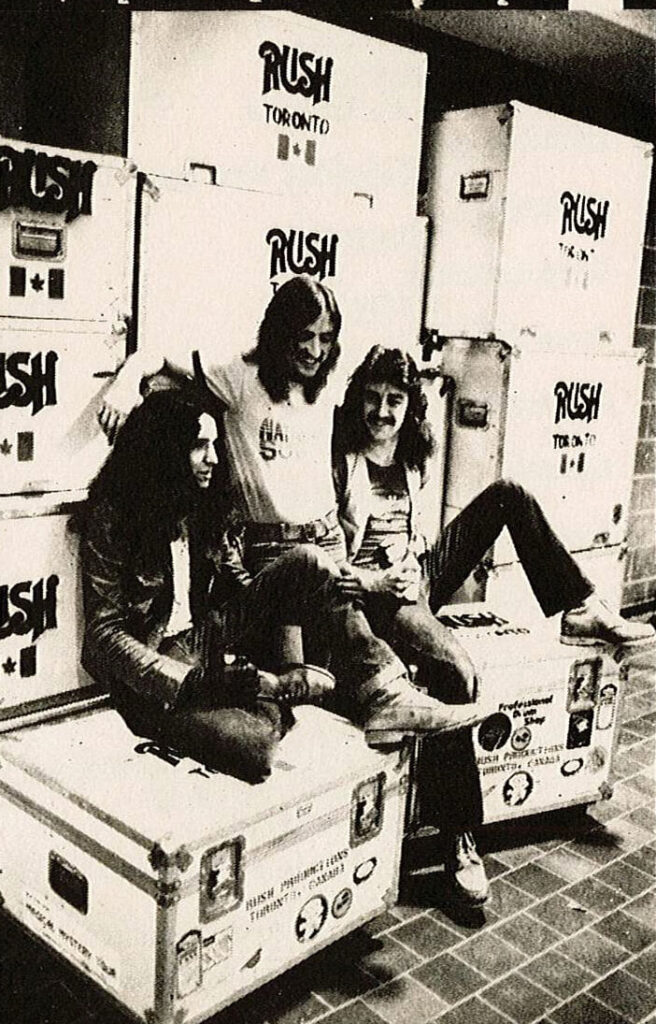
Photo by Richard Fegley
It was the same way with Bubba—I didn’t pick it, and probably wouldn’t have. It came from Andrew MacNaughtan, the band’s main photographer from around 1989 until his tragically early death in 2011. During those years Andrew shot us casually and formally all over the world, including the portrait that opens this story (with expert Photoshop work from Hugh Syme), my all-time favorite. (Bubba’s, anyway.) In the early ’90s, Andrew also traveled with us on a couple of tours as a personal assistant. (Poor guy.)
Back in those days, early in a friendship that would deepen over the years, Andrew started calling me Bubba. Originally Southern slang for “brother,” that title has grown to convey a “good ol’ boy” stereotype—even “redneck.” I could only assume Andrew was calling me that because I was pretty much the “Anti-Bubba” (I hope that’s what he was thinking), because, you know, I had read books, and written them, and cared about art, and cooked for my family, arranged flowers, and was friends with gays and brown-skinned people.
(That duality amused me when I named “Bubba’s Book Club,” for example—a counterpoint to Oprah’s. Later, the invention of “Bubba’s Bar ’n’ Grill” merely aimed at teaching other Bubbas how to cook “Good Simple Food.”)
An even earlier nickname given to me, “The Professor,” had an an equally ironic root. It was not, as many strangers assumed, some reflection of admiration from the Guys at Work for my intellect and learning. Oh no. Nor did it reflect an actual university degree, as some rumors held. No, the Guys at Work were simply equating my demeanor with the character on “Gilligan’s Island,” played by Russell Johnson.
Not terribly insulting—but not exactly cool, either.
(In the middle of writing this story, Russell Johnson suddenly appeared in the news, because he had died. However, he was 89, so not a bad run. And for almost fifty years his only real claim to fame had been that role as “the Professor”—he had “dined out on it,” as the Brits would say.)
The screwball sitcom “Gilligan’s Island” only aired for three seasons in the mid-’60s, but for decades after it was widely syndicated. During the show’s first season, Professor Roy Hinkley, Ph.D, was not even included in the opening theme song—the five other characters were mentioned by name, but he and Mary Ann were lumped into “and the rest.”
(Bubba suggests that our sitcom should be retitled, “Bubba . . . and the rest.”
The dry-humored Professor sniffs, “Hi-lar-ious, Chucklehead.”)
Early episodes revealed that the Professor was a research scientist and “well-known Scoutmaster.” (I do hope that wasn’t a veiled stereotype inserted to explain his seemingly “unnatural” lack of interest in sultry, sophisticated Ginger or sweet, virginal Mary Ann.) Cynical viewers have long noted, “Isn’t it odd that the Professor could make a radio out of a coconut, but couldn’t fix a hole in a boat?”
So . . . a question arises that has honestly never occurred to me before: which is the “real me?” The Professor, or Bubba?
Whoa. Perhaps that duality is like what a writer for Spy magazine once described as a metaphor of morality for people who grew up in the era of Disney cartoons: Above one shoulder is the “Good Goofy,” an angel, and above the other is the “Bad Goofy,” a devil. (Though Bubba is not really a devil, and the Professor is certainly no angel.)
The Bubba side of the doppelgänger, as he is shown above, would surely say, “Let me pour you another drink and we’ll talk about it. Have some laughs.”
But the Professor would cut in, “No, no, that won’t do. We are on sabbatical. We have to achieve something.”
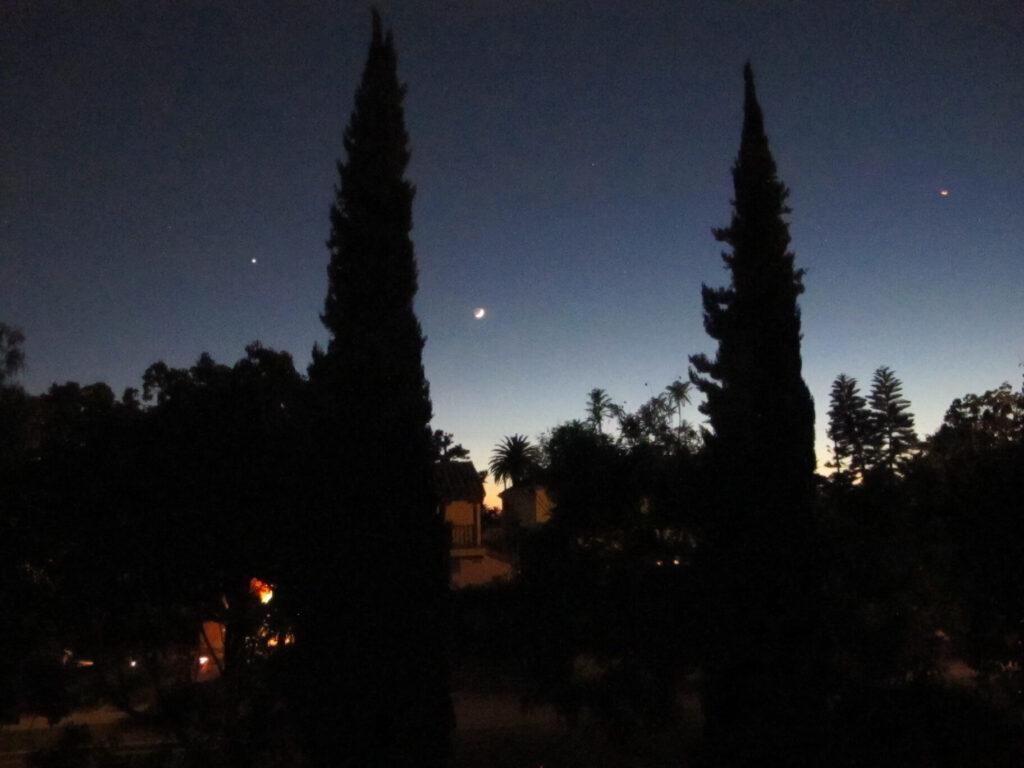
[Inspiring an Accidental Poem By The Professor]
Venus, cypress, crescent moon with earthshine
Royal palm, fan palms, Norfolk Island pines
Ah, sweet sabbatical. The Professor’s first intention was to begin this story with a rumination on that subject—wanting to open with the above night sky and spontaneous couplet. Bubba wanted to call the story “Black Sabbatical”—because that made him chuckle.
However, that title was ultimately doomed to fail, simply because there was nothing dark about that time—quite the opposite. Even in December, the California night sky sparkled with light and hope, and we can think of few times in our life that have been brighter. (“Some days were dark; some nights were bright.”) But somehow “Golden Sabbatical” didn’t make Bubba smile the same way.
Later, when the Professor pitched his “high concept” for the “Bubba and the Professor” sitcom, Bubba could only agree.
However, it turns out the words “sabbatical” and “sabbath” do have similar roots. An ancient Hebrew word (yes, Shabbat) means “a ceasing.” The worthy Wiki gives us this nice clarification:
“In recent times, ‘sabbatical’ has come to mean any extended absence in the career of an individual in order to achieve something. In the modern sense, one takes sabbatical typically to fulfill some goal, e.g., writing a book or traveling extensively for research.”
Oh yes, that works for us. Again we offer our definition of the perfect life: “a working vacation.” As we happen to be taking an “extended absence” from our career, and aim to spend that time well, the truly key words in that definition are: “in order to achieve something.”
Well, yes. That’s the difference between a sabbatical and a vacation—something more like recreation than rest. (Though rest is nice, too, of course.)
“Traveling extensively for research” takes on a different meaning when your work involves traveling extensively. We were thinking of something more like “Staying home extensively for research.”
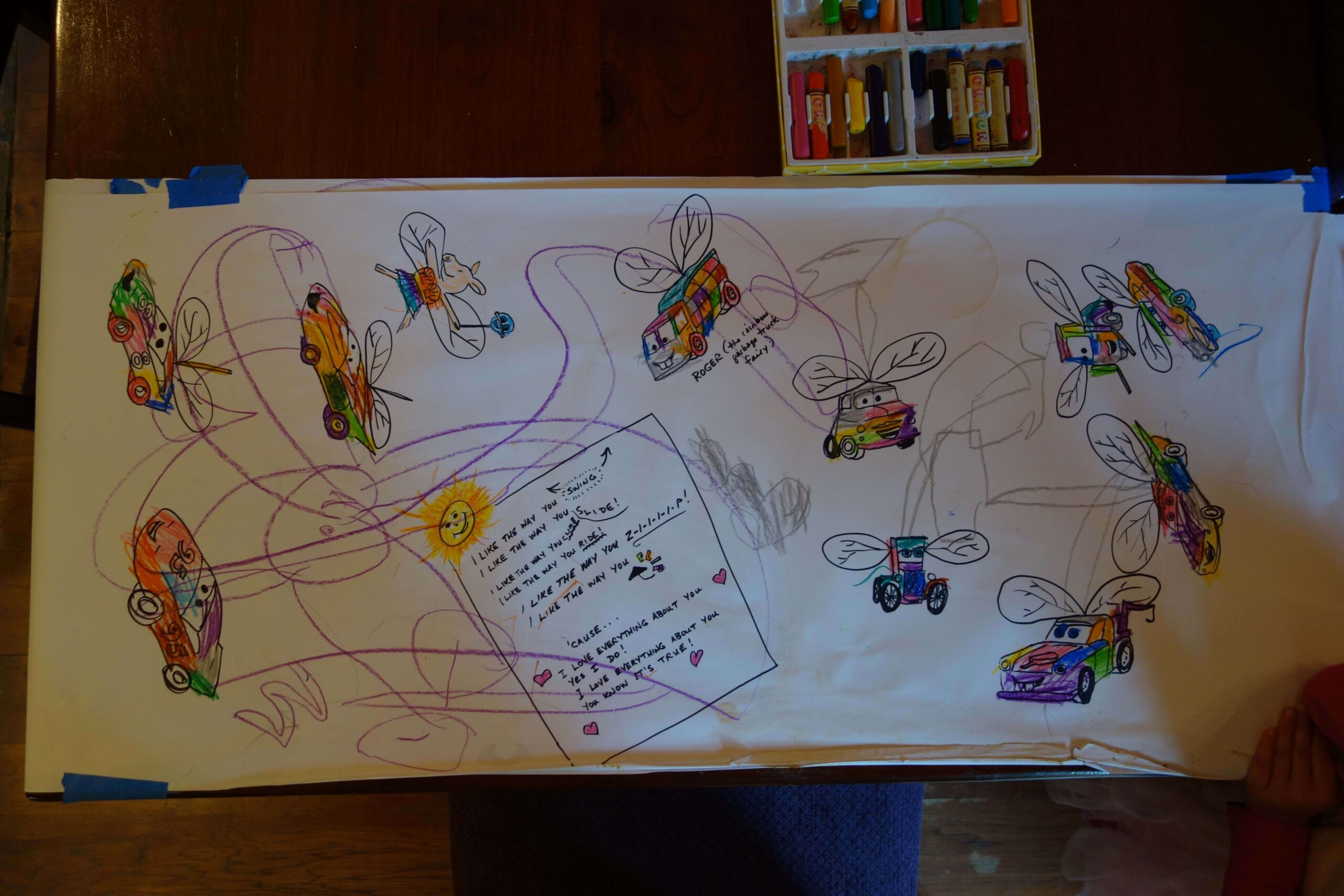
“Achievement” can be broadly interpreted to include spending time with our four-year-old daughter, Olivia. Out of the many church signs we have collected and held up for ridicule over the years, a vanishing few have reflected the kind of deep, ancient wisdom that transcends faith and offers timeless human truth.
“How Does a Child Spell Love? T-I-M-E.”
Bubba and the Professor always try to remember that. At some point in every day we are summoned to be the “quick sketch artist” for Olivia’s fantastic visions. She will announce, “Mater, I want you to draw something.” (Yet another nickname! After the Bubba-like tow truck in the Cars movies, voiced by Larry the Cable Guy. We won’t go too deeply into that.)
Fetching our Sharpie, we sit on the floor by her little work table, and roll out a fresh sheet of paper, then stick it down with blue tape. Olivia describes what she wants—in this case, various characters from the Cars movies as “rainbow fairies,” including one of her own invention called Roger the Rainbow Garbage Truck Fairy. (Ha—Pixar never thought of that.) A couple of the cars had to have dipstick-shaped headgear, like Dipsy from “The Teletubbies.” (That’s where the laughing sun comes from, too.) Olivia the pig dances ballet in the air, wearing mermaid shells, fairy wings, and a wand shaped like Mator, the UFO in Mater’s Tall Tales. Because, well—obviously!
It’s Olivia’s world! We just live in it . . .
Olivia dictates every detail as she envisions it, every facial expression and gesture. We draw what she directs as closely as we can, then she colors it in. Here Olivia has also added “zoom lines,” some Joan Miró swoops, and Cy Twombly-style decorations.
In the middle we printed a new verse for a song we had been working on, “I Love Everything About You,” so we wouldn’t forget it. We already had two verses and a chorus, and it was certainly one of our finest collaborations.
In a medium swing feel, the first verse went like this [with accompanying choreography]:
I like the way you think [point to temples and sing cymbal ride, ‘ding-de-ding, ding-de-ding’]
I like the way you talk [make hand puppet talking]
I like the way you da-a-a-ance [add frantic choreography]
I like the way you walk [add walking fingers]
I like the way you si-i-i-i-ing [falsetto long and loud!]
I like the way you do . . . [shrug]. . . everything
’Cau-au-ause [long rising note, over tempo shift to medium shuffle]
I love everything about you
Yes I do
I love everything about you
You know it’s true
(Unfortunately, we realized later that the chorus melody echoes “Tell Him,” by the Exciters—“I know—something about love”—from 1962, so we’ll have to adjust that before we start recording.)
Then into the second verse, back to the medium swing feel:
I like the way you count [two, three, four, five]
I like the way you spell [a, b, c, d]
I like the way you bou-ou-ounce [jump up and down three times saying ‘boing, boing, boing’]
I like the way you . . . [long sniff] . . . smell
I like the way you ru-u-u-un (dash quickly around the kitchen counter]
I like the way you have fun—
[Repeat chorus]

That October day, we worked out the third verse, while refining our graphic arts. All through the later months of 2013, and into 2014, our sabbatical time included that kind of “creative play.”
Looking forward to our sabbatical year, and gradually formulating our goals, in early January we outlined our plans for what we hoped to achieve, in a letter to our friend Craiggie. He only lives across town in South Pasadena, and we had seen him just a few days before—with our families, attending “Bandfest,” as we have for the past three years. (A few days before the Rose Festival parade, selected marching bands from around the world perform on a football field. Many of the bands, with dazzling costumes, spinning flags and batons, and nimble footwork, create a wondrous combination of music and choreography that is much more artful than they can deliver “on the march,” as it were.)
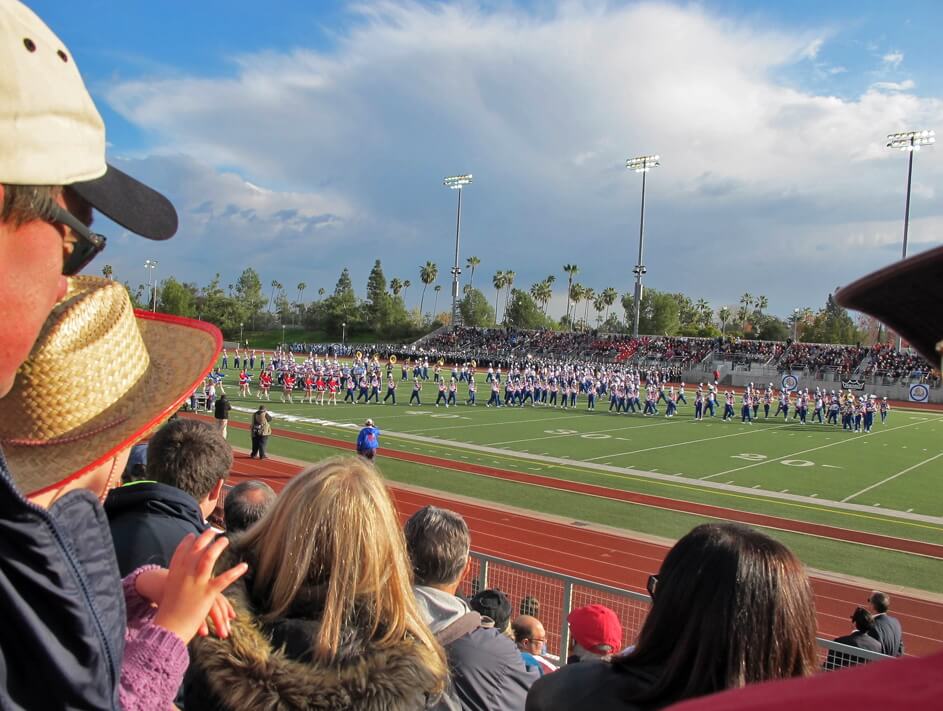
Photo by Craig M. Renwick
Like many of our friends, and ourselves, Craiggie writes long old-fashioned letters. Often these are employed as “sounding boards,” when we’re thinking something through for ourselves.
(“How do we know what we think until we see what we write?”)
Here is part of what we wrote to Craiggie that morning, “at the gate of the year,” describing our hopes for a sabbatical 2014.
This isn’t a time to “do nothing,” but quite the opposite—a precious opportunity to do different things.
Work has been going forward on the Clockwork Angels graphic novel, and I’m getting pretty excited about it. I have been drawn into being more involved with the project, especially the artwork, loving the opportunity to see my vision of Crown City and the steamliners portrayed. (That’s where we are so far, in the first “issue.”)
The live-show rear-screen stuff was much more generic steampunk, sometimes of the more dystopian genre, which is opposite to the truly fantastic and rather splendid way I see Albion, with the darker scenes to come in Poseidon—“on the waterfront.”
(Did you know Poseidon was the mythical capital of Atlantis? That’s why I liked giving it the darker spin, an outlaw port full of scoundrels and misfits.)
The rear-screen stuff is not my department, and I can’t supervise everything, so I just let that go. Hugh’s artwork was always totally in sync with my vision, and now this is a chance to really nail every detail of the different settings.
The artist, Nick Robles, is quite excellent, at both characters and outlandish architecture, and takes “direction” well. Kevin [Anderson] is writing the script—I am surprised to learn that he basically maps out the whole thing, panel by panel, even dictating their relative sizes, and the artist “just” fills them in.
Interesting that Nick has previously been most active in “hard” sci-fi illustration, and later admitted he wasn’t that familiar with the steampunk aesthetic. Thus his first renderings of Crown City were much more generic—the typical setting that resembles Victorian London. Oh no, not my Crown City! It is something entirely more monumental and fantastically exotic. I had to steer him back toward the “grandeur” of sci-fi cityscapes, something more awesome, spacious, and—yes—Utopian.
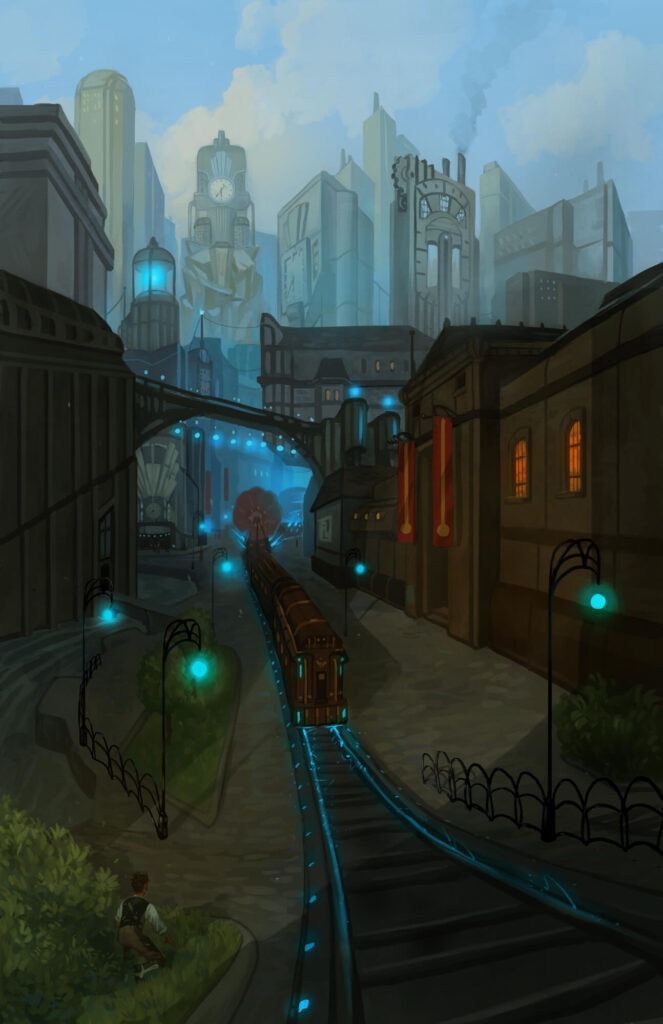
Art by Nick Robles
Then I’m thinking it’s time to publish another collection of stories. Although the title of the calendar was conceived only for that purpose, I’m starting to like it for a book. Maybe Far and Near: On Days Like These.
The cover image in my mind is still that North Yorkshire one, so that would work. (One thing I loved right away about the title “On Days Like These” is that it works for every image, and every day!) Then a variety of scenic photos on the back, as in Far and Away, to suggest the extent of the settings within.
I would like to collect one more story, maybe of February in Quebec (a recurring theme!), then would want to write new intro and outro pieces for it.
Putting together a book, even of existing stories, is no small undertaking, collecting all the elements for publication, supervising the layout and proofreading, and preparing all the “ancillary” material—the “front matter,” they call it.
However, it is certainly rewarding to hold the finished product in your hands—and send it to all your friends!

Photo by Brutus
A proper sabbatical year should include both other modes of study, and travel (for “research”), and a chance to delve deeper into your own “specialty”—in my case, hitting things with sticks. I have already talked with Peter Erskine about working with him again, maybe around springtime. Something worthwhile is sure to come out of that…
All of a sudden today I am jonesing for a long motorcycle ride. Over the past few months I kind of consciously put that aside, deliberately wanting to make everything about my everyday life different, and give the usual daily activities in my recent life—drumming and motorcycling—a rest.
That has been good, but this morning as I backed the car out of the garage to head for the Y, I glanced at my shiny red GS sitting there, and—a spark went off in my brain.
Probably in the so-called “reptile brain,” a pre-literate grunt, “Want. To. Ride.”
So I’m letting that desire float up into the higher levels of cognition, to figure out how to satisfy that primitive urge in some creative way.

At the time of writing that letter to Craiggie, we hadn’t yet had the divine inspiration for “Bubba and the Professor,” but that final passage is definitely a perfect example of how we work together. Bubba has an urge; the Professor finds an intelligent way to scratch it.
The Professor was busy with his own itches in late 2013, because one unexpected achievement was an outpouring of “educational” writing. (The quotes seem necessary, because that quality can only be hoped for, not assured.)
First a British drum magazine asked for some thoughts on our solo excursions on the Clockwork Angels DVD.
(They seem to have choked on the carefully wrought 4,000 word response, for we’ve heard nothing back from them!)
Then the author of a book called something like By Drummers For Drummers asked for some thoughts on recording. Perhaps a book will be a more suitable medium for the 4,000 words we gave him—though we haven’t heard back yet.
A music scholar contacted us about a “senior comprehensive research paper” he was writing on the teachings of Freddie Gruber. He sent us a detailed questionnaire, which Bubba insisted we ignore, and we proceeded to tell the story our way—improvising around the questions in a way similar to the way we describe practicing in that essay: Just start playing, and work the exercises into whatever the day’s “story” becomes. So we sent him about 3,000 words on that worthy subject—no word back on that one, either.
But never mind—we’ll find some place to publish it, for the excellent cause of keeping Freddie’s memory, and his teachings, alive.
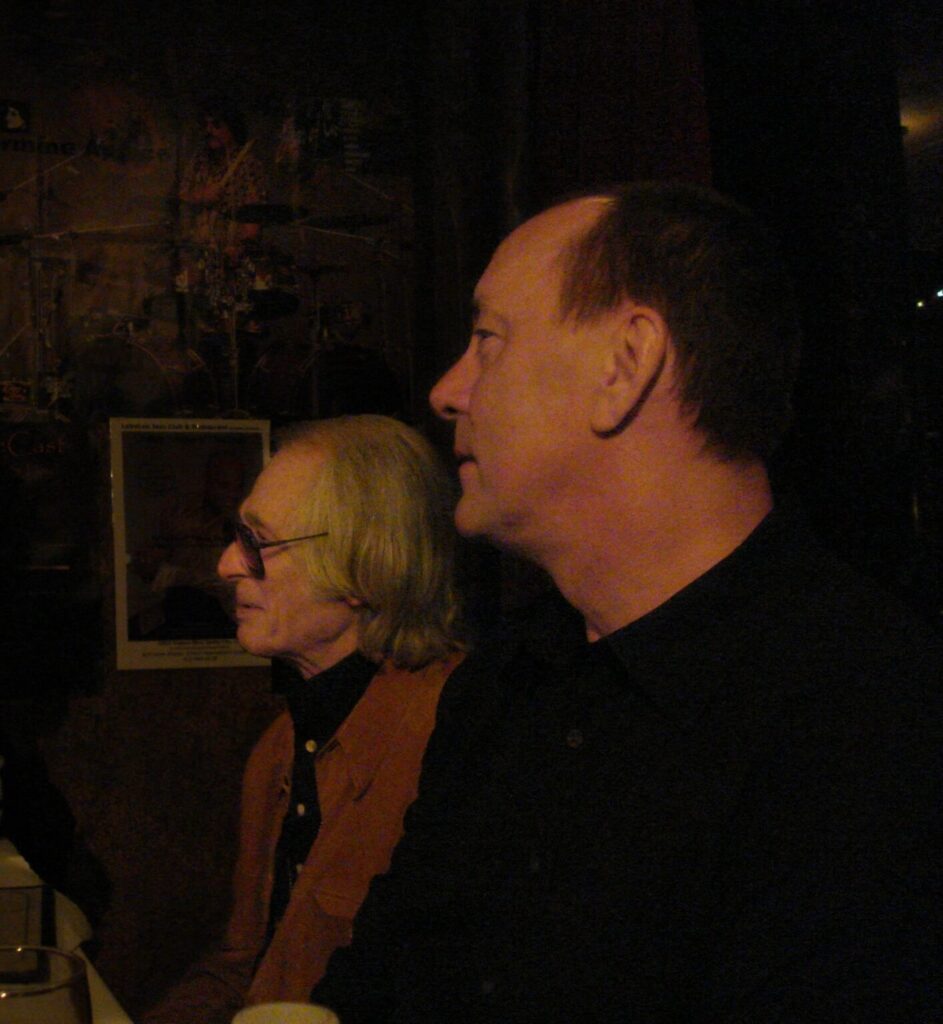
Wathcing Joey Heredia Play
Photo by Rebecca Truszkowski
All of that writing kept the Professor fairly busy, while Bubba played with his cars.
On the subjects of soloing and recording, and studying too, we realize that we have been preoccupied by all of those pursuits for over forty years—so we have a great number of experiences, and a little advice, to share. And given the time—a sabbatical time—it seemed worth doing.
Truth be told, that kind of writing is not as entertaining or rewarding as these little “open letters” always are—no pleasure of reading them over at the end of the day with a double-old-fashioned glass clinking with ice and amber nectar. (A true Bubba-meets-the-Professor moment if there ever was one!) There are no surprises from a day’s work, like the unexpected directions “undisciplined” writing can reveal. Those technical essays were more of a chore, and were simply “worth doing.” Still, we couldn’t help chipping away at those tasks with the approach to work and life drilled into us early by our father.
“If a thing is worth doing, it’s worth doing well.”
Bubba chimes in with a snort, “You mean, it’s worth beating yourself up day and night trying to get it right!”
The Professor adds with a dark laugh, “And worth beating yourself up about forever after—because you didn’t get it right.”
But that’s just me.
I mean, him . . .
